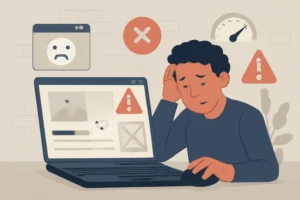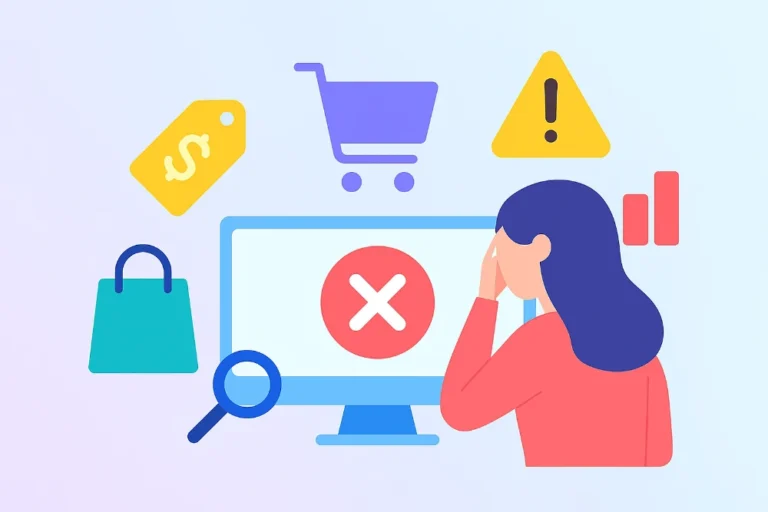The internet business explosion has unveiled boundless, promising possibilities for newcomers, with low entry barriers and possible access to a global market. However, there is often a misleading sense of ease. Many new online businesses fail, however, through a chain of avoidable errors. These are not giant failures but quietly draining errors that creepily chip away at momentum. This book discusses eight of the most frequent blunders newbie e-commerce firms make, providing grounded suggestions for entrepreneurs to build a stronger and healthier platform for growth.

1. Not Conducting Market Research and being unable to spot the Niche
- The Problem: New companies enter the market unaware of their target customer, actual demand for their product, and competition. This typically comes from a positive assumption of thinking that a web presence is sufficient to guarantee customers.
- Consequences on Growth: This failure results in dismal sales, poor product-market fit, and futile marketing efforts. The company remains unnoticed and unheard and puts money into products that do not have any immediate market demand.
- The Solution: Conduct thorough market research. Learn about pain points of customers, study competitors to identify gaps in areas, select a niche that is niched and untouched, and build a winning value proposition that makes your product uniquely stand out and differ from others.
2. Bad Website Experience and Performance

- The Error: Too many new companies view their website as a fixed installation, forgetting that it can also be an active customer experience tool. Sluggish loading, unresponsive design, or clunkiness on different devices intimidates prospective customers from the outset.
- Impact on Sales: Bad design and slow performance drive away visitors, resulting in high bounce rates and deserted shopping carts. Confusing navigation or a more than necessary checkout means instant money lost and an awful first impression.
- How to Fix: Select a new, mobile-optimized site theme that is adaptable to all screen resolutions and sizes. Optimize speed by removing all unnecessary things. Optimize navigation and simplify the checkout process with fewer steps for simple transactions.
3. Bad Inventory and Fulfillment

- Common Pitfalls: Companies will overstate optimum inventory levels or underestimate shipping complexity and end up having frustrating stockouts or idle, redundant inventory. Organizational issues with fulfillment procedures just fuel these fires.
- Future Problems: Stockouts result in lost business and upset customers. Excess inventory constrains capital and cash to hold. Failure to meet orders means delay or damaged goods, taking a severe toll on customer confidence and company reputation.
- Actionable Steps: Establish stable inventory control measures and generate robust demand forecasts. Design customer-friendly order packing and shipping procedures, and employ high-rated fulfillment services to ensure smooth delivery. Check delivery times periodically and ship securely.
4. Ineffective Marketing Strategy

- Where Business Gets It Wrong: The most common error is launching an e-commerce store without a clear, vision-driven strategy for visibility. New companies innocently think that products placed on the internet will automatically attract visitors and consumers.
- Impact of Low Visibility: The online shop is left perplexed invisibly without any marketing. This causes low traffic to the website, poor conversion rates, and extreme challenges in gaining momentum and getting popular, thereby preventing it from gaining new customers.
- Best Practices: Maximize search engine optimization from the start. Practice targeted email marketing and frequent posting on social media of valuable content. Add paid advertising once momentum has been generated, and aggressively track campaign effectiveness.
5. Avoid Customer Support

- Neglected Priority: The majority of new companies view customer support as an episodic process, rather than an active measure to instill confidence. If customers are unable to receive support on time or have delayed responses, the company’s trust is broken early.
- Why Trust is Lost: Unavailability triggers negative word of mouth that harms the brand’s image. Ambivalent complaints leave unhappy customers who lose their purchases and discourage others, so losing opportunities to enhance.
- Relationship Building: Provide several open lines of communication. Answer promptly, sympathetically, and concisely. Anticipate follow-up on orders, request feedback, and handle complaints professionally.
6. Ignoring Data and Analytics

- Lost Opportunity: Entrepreneurs default to making decisions on instinct rather than on reality. Without monitoring visitor habits, product performance, or areas of user drop-off systematically, there’s no quantifiable fix to correct it.
- Consequences of Neglect: Partial data = opportunities to maximize your store, generate most conversions, or correct things. Decisions are made on opinion, leading to inefficient investment and stagnant growth.
- More innovative Use of Data: Leverage Google Analytics and build custom dashboards. Track vital metrics, including conversion rate and cart abandonment rates. Experiment with different layouts or prices with data, and allow facts to dictate your adjustments.
7. Underpricing and Profit Margin Blunders

- What Went Wrong: New companies typically try to lock up customers through underpricing, without considering all the expenses incurred, thereby obtaining a huge amount of sales but no long-term profit.
- Underpricing Risks: Priced with no sensible margin of profit, working capital exhausts quickly, causing reinvestment to be useless. It also erodes perceived product value, making future price realignment useless without losing customers.
- Pricing Best Practices: Fully account for all costs, such as product cost of acquisition, shipping, advertising, and transaction costs. When comparing prices to competitors’ pricing, make sure your price leaves ample space for improved profit margins and promotions in the future. Recheck margins every month.
8. Unrealistic Financial Planning

- Common Mistakes: Most emerging online business operations overestimate the real amount of money needed so as to make them stay alive by quite a considerable margin. They expect to generate quick returns and do not cherish the necessity of having ample working capital in addition to a properly planned budget.
- Penalties of Bad Planning: Without planning, revenues are easily outpaced by expenses. It causes crippling cash flow issues, increased stress, slow growth, and eventually, early business shutdown, generating huge personal stress.
- Intelligence Management: Set an honest monthly budget with realistic sales and complete expense numbers. Manage all costs with close attention and maintain emergency cash balances during lean months. Focus on sustainable and steady growth, and avoid deceptive, high-growth objectives.
Conclusion
To succeed at e-commerce, it is not so much about never committing an error but constantly seeking and correcting the most important ones before they derail your success. Errors are more often the result of seemingly unimportant choices with long-term implications. By watching out for possible mistakes, business owners can build a solid groundwork, provide better customer service, and build a sustainable online company in the long term. With proper planning, ongoing learning, and flexibility, e-commerce success is not just possible but also sustainable.


